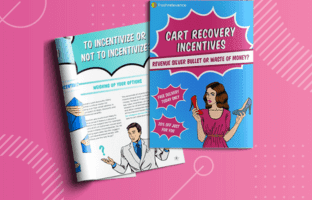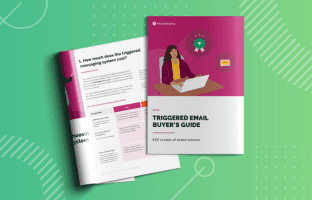learning path
The complete guide to cart abandonment

Cart abandonment is a key contributor to revenue loss for eCommerce businesses.
Understanding how to drive these consumers back to your website is fundamental to increasing revenue and winning loyal customers.
This guide contains everything you need to know about cart abandonment, from what it is, to why it happens, to how you can devise a strategy to combat it.
What is cart abandonment
If you’re an eCommerce marketer, or own an eCommerce website, you may be all too familiar with the term ‘cart abandonment’. Cart abandonment arises when a shopper leaves an eCommerce website after beginning the checkout process and adding items to their online shopping cart, but without completing the transaction.
Cart abandonment email statistics
This a common issue – around half of shopping carts are abandoned, according to our research.
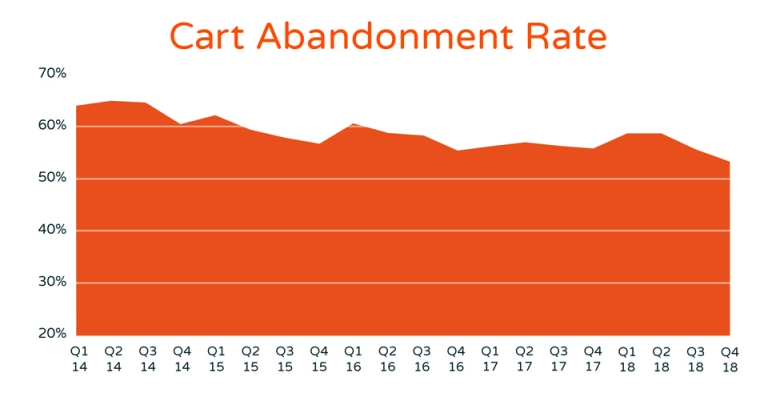
Figures from Fresh Relevance clients, Q4 2018
Turning this lost revenue into sales is a key concern for retailers and digital marketers alike. If shoppers leave after carting products, sending them shopping cart recovery emails can give a sales uplift of 7% – with an additional 3% if you add browse recovery emails too.
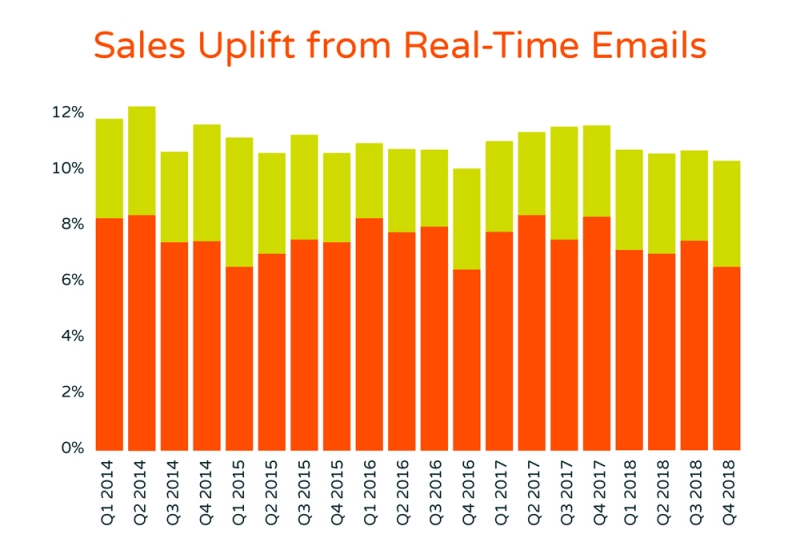
Figures from Fresh Relevance clients, Q4 2018
In reality, the issue of abandonment starts well before the cart. Only shoppers who visit your website can actually make that all-important purchase. Also, from 100 shoppers visiting your website, just 39 people get through to looking at products, with 12 putting their products in the cart. Then, you have cart abandonment and checkout abandonment to content with.
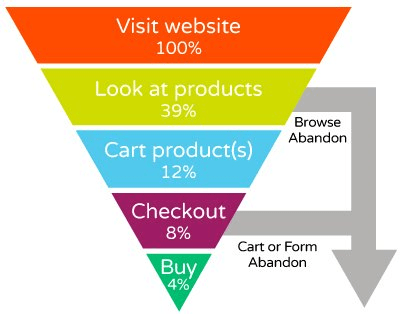
How to calculate eCommerce cart abandon rate
In order to calculate the cart abandonment rate for your site, divide the number of abandoned carts by the total number of carts created.
Once you have this figure, you’ll have a better insight into how significant cart abandonment is specifically for your website. This will allow you to start looking at what factors may be contributing to cart abandonment on your site, and how to prevent it.
Cart vs browse abandonment
Both browse and cart abandonment are key contributors to revenue loss for eCommerce businesses. Understanding how to drive these consumers back to your site is fundamental to increasing revenue and winning loyal customers.
Browse abandonment is when a shopper visits your site, but leaves after browsing, without adding anything to their shopping cart.
Cart abandonment occurs when a customer adds potential purchases to their shopping cart, but leaves the site without completing their purchase.
While this guide focuses on cart abandonment, remarketing to browse abandoners is another essential way to generate additional or ‘lost’ revenue from your eCommerce business.
Ways to reduce shopping cart abandonment
Reasons for cart abandonment
So why do people spend time selecting items to put in their cart, only to abandon their prospective purchases before check-out?
It’s worth bearing in mind that people often don’t intend to abandon their carts – there are many reasons why this can happen.
These include poor customer experience:
- Poor customer journey
- Lack of payment options
- Lack of product details
- Insufficient shipping options
And the complex customer journey:
- Becoming distracted
- Using the cart to save items for later
- Going to do more research
- Customers simply forgetting to complete a purchase
First, it’s important to optimize the customer experience throughout the purchase journey.
Then, ensure that you send targeted emails to abandoners to re-engage as many customers as possible.
How to reduce cart abandonment
While cart abandonment can never be completely prevented, there are factors that can drastically reduce the chances of it occurring. Here are some important areas to consider:
Product details
Shopping online without access to a tangible product means that consumers require a good level of detail before they can commit to making a purchase. Without a complete product description and features, such as 360 degree videos and virtual dressing rooms, shoppers will find it difficult to imagine how the product will look in real life and to proceed to checkout.
Seamless customer experience
Ensure that the process from browsing for products through to making a purchase is as user friendly and straightforward as possible – no matter which device is used.
Convenient shipping options
Do you offer delivery options that meet the needs of online shoppers in terms of convenience and match your competitors on pricing?
Competitive pricing
Is your pricing competitive? Customers are likely to want to compare your pricing with another eCommerce store or high street stores. If your prices are higher than your competitors, you may need to find, and clearly communicate, other good reasons for shopping with you.
Personalize and optimize the customer journey
Ensure that consumers have a streamlined, personalized experience while shopping with you, and during any follow-up activity. Proven tactics include:
- Relevant product recommendations to help customers find what they need
- Social proof to reduce purchase anxiety and build trust
- Dynamic messaging like countdown timers to increase urgency
Myths about cart abandonment
As mentioned above, there are many well-documented reasons why a customer might abandon their cart prior to making a purchase.
However, what about much-cited myths about cart abandonment that aren’t so true?
Customers don’t want emails
A common misconception regarding cart abandonment is that remarketing emails will annoy or alienate the customer and drive them away from the brand. But this isn’t the case.
Research and numerous success stories suggest that targeted remarketing emails which highlight products relevant to the consumer do in fact drive sales and increase brand loyalty.
Cart abandonment emails are spam
With the introduction of GDPR in the EU, many companies and marketers have also expressed concerns around the legality of email remarketing, and whether this is classed as spam.
However, as these are specific, personalized emails based on the content of an abandoned cart, they do not fall into this category. They are also being sent to a person who has an existing relationship with your brand (after all, to send a cart recovery email, you need to have the shopper’s email address, right?), so this is a legitimate interest and proven way of generating revenue.
What are abandoned cart emails?
A shopping cart recovery strategy is an essential part of your eCommerce marketing plan. Shoppers have busy lives, and may often find themselves losing track of what they were doing, or getting distracted by a phone call or text message, and never completing their purchase.
In the age of mobile technology, which allows people the freedom to do several things at once, this is more pertinent than ever.
A lack of cart recovery strategy could spell the end of a customer journey, when a carefully executed recovery campaign could result in a loyal customer.

Shopping recovery emails are essential for distracted consumers
Cart abandonment emails are a highly effective sales recovery tactic, and can increase your sales by 7%. The messages are sent to customers who have added products to their cart but are yet to complete their purchase.
Shopping recovery emails are a type of triggered email. This means that when a cart abandonment signal is raised on your website, an email or series of emails is triggered after a certain interval.
Cart abandonment alerts tend to have higher conversion rates than bulk email marketing because they treat customers as individuals, sending them relevant messages based on an action they have just taken.

Highly personalized cart abandonment emails can be the difference between a consumer returning to make a purchase and losing them.
Cart recovery email best practices
Sending generic cart recovery emails to masses of shoppers isn’t going to win you customers. Learn how to craft effective cart abandonment messages to drive sales and increase revenue with these top tips:
1. Pay attention to your email subject line
The subject line and preview text are sometimes an afterthought when crafting an email. However, a good subject line can make a huge difference to your open rate, and your conversion rate.
It is crucial that the shopper knows what the email is about from first glance. Personalization is a key part of this – for example, use the product name to draw the shopper back in.

2. Make it clear who you are
It may sound obvious, but it is important that it is easy for the customer to quickly identify who the email is from. If it is not immediately obvious that the email comes from a) a trusted sender and b) a brand they are interested in, it is unlikely that they will engage with the email. Check the email address and display name that your emails are coming from. Does it provide a clear indication of the sender, and seem trustworthy and credible?
3. For real results, email in real-time
Your email needs to be real-time. If you are sending recovery emails to abandoners days after they visited your site, your chances of winning them back are minimal.
For optimal results, aim to send your cart abandonment recovery emails around 30 minutes after the shopper visited your site.
4. Personalize, personalize, personalize
Ensure that shoppers can identify with your email, and that it reminds them of why they visited your site in the first place, by personalizing it as much as possible.
Personalization can include using product images of items they put in their shopping cart, complete with a description and links to make purchasing the item easy.
You may wish to include the whole cart of items that were abandoned or recommend alternative products in case the shopper couldn’t find what they were looking for.
Here’s an example of a personalized shopping cart recovery email:
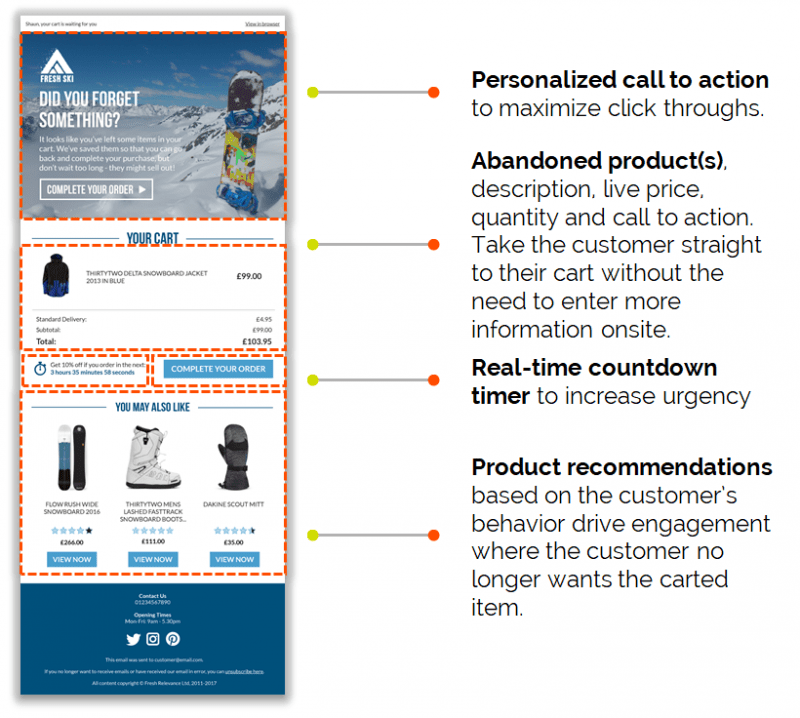
5. Consider multi-step campaigns
You might think that sending more than one email is overkill and will annoy customers.
In fact, multi-step cart recovery campaigns are helpful for distracted customers.
On average, sending a multi-step cart abandonment program generates a sales uplift of 21% compared to a single cart email (9.2% vs. 7.6% sales uplift).
An email could be sent 30 minutes after abandonment, 24 hours later, and then a follow up email after one week.
If the customer makes a purchase before the email series is complete, the program should be abandoned. Otherwise, customers will be frustrated by an irrelevant email.
6. Don’t forget browse abandonment
Browse abandonment is when a shopper visits your site, browses, and leaves without adding anything to their shopping cart or proceeding to checkout. While cart and browse abandonment are related, and there are similar techniques to combat each issue, the root causes are not identical. Also, the messaging to encourage customers to return and finish shopping is different. Learn more with our complete guide to browse abandonment.
5. Don’t offer blanket incentives
Cart abandonment incentives are a great way to encourage consumers to return to your site to complete a purchase. However, winning shoppers through incentives isn’t always as straightforward as it seems.
It can be tempting to offer a discount code to customers every time they abandon their shopping cart. However, this isn’t always the best way forward. First of all, incentivizing costs your brand real money, and doesn’t always yield great results.

Research conducted by us found that blanket incentivizing doesn’t offer the best return on investment. For example, serial abandoners may respond just as well to a simple reminder email. However, targeted incentive emails offered to one-time abandoners can have a real effect on the open rate of the email, as well as the number of sales.
Being targeted with your coupon codes is also important for another reason – blanket incentivizing can devalue your brand. If consumers get an incentive offer every time they abandon their basket, they may become used to waiting for offers, and perceive buying at full price as bad value.
Read more about the pros and cons of cart recovery incentives in our eBook “Cart Recovery Incentives – Revenue Silver Bullet or Waste of Money?”
Abandoned cart email examples
1. Include an exact copy of the abandoned cart
Include a simple call to action to checkout, along with a copy of the abandoned shopping cart. You’re more likely to entice customers back to your online store if they remember why they were shopping with you in the first place.
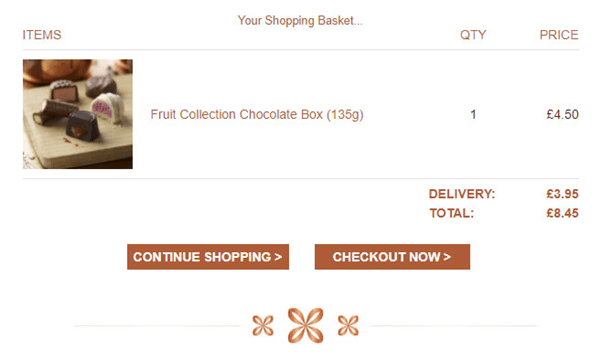
Thorntons recreates the shopper’s abandoned cart
2. Personalize the hero image
If you include a hero image, make it more engaging by tailoring it to the shopper’s interests. It could be related to the category of the carted product, or even the brand if you’re a retailer offering multiple brands:

Jessops shows a personalized hero image based on brand
3. Show product recommendations
Maybe the customer abandoned because they didn’t find exactly what they wanted. This means that by displaying alternative products, you can encourage them to engage.
Or perhaps you’ll be able to upsell by offering related higher-margin products.
Make sure these appear underneath the carted product so as not to distract from the most engaging call to action.

A Yumi cart abandonment email including product recommendations
4. Add social proof
Customers often abandon their cart because they are anxious about making a final decision. You can reassure shoppers to complete their purchase by providing social proof e.g. ratings and reviews.
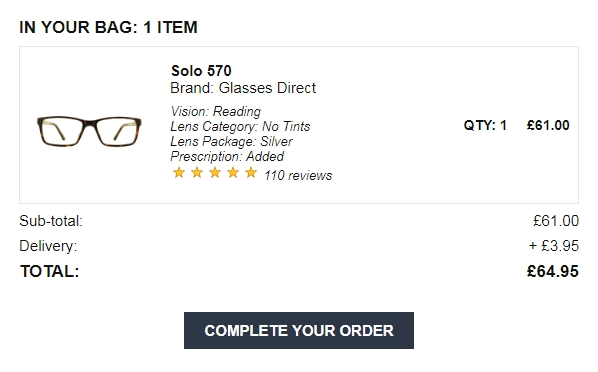
Glasses Direct combats abandoned carts with social proof
Cart abandonment solutions
The most effective way of bringing customers back to your site to complete their purchases is by sending real-time triggered messages, via a specialist cart abandonment solution.
At Fresh Relevance, our average client sees a 7% sales uplift from sending cart abandonment emails.
Successful cart abandonment email campaigns
The most effective way of bringing customers back to your site to complete their purchases is by sending real-time triggered messages, via a specialist cart abandonment email provider.
Many top brands are using Fresh Relevance for cart abandonment remarketing, with outstanding results. Take a look at the following five case studies, which highlight the way leading names have used the Fresh Relevance platform to win back customers and increase revenue.
Rip Curl saw sales increase by more than 10% with eCommerce personalization, through the use of a combination of abandonment emails and ‘recommended for you’ dynamic content SmartBlocks.
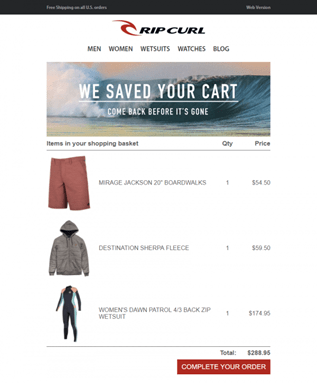
My Optique Group, which includes Glasses Direct and Sunglasses Shop, alongside other leading brands, have increased revenue through cart and browse abandonment remarketing, which equates to 4.2% of all sales.
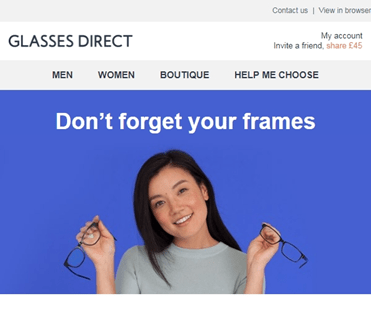
Awaze has seen a 16% increase in AOV across their Cottages.com and Hoseasons brands with multi-step cart and browse abandonment emails. The company sees a 14% conversion rate for the first cart abandonment email they trigger, and then a 3% conversion rate for the second email that gets triggered 24 hours after abandonment.
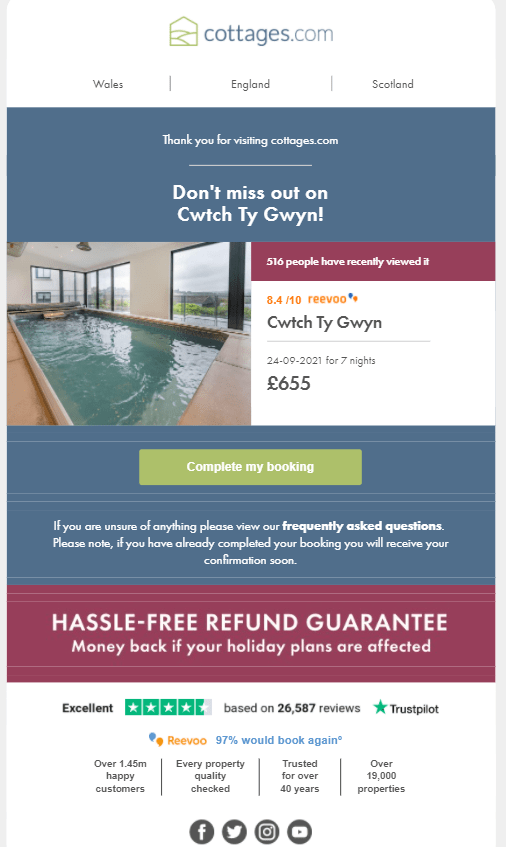
Vapouriz has seen a 10% increase in AOV from their cart abandonment emails. The company’s cart abandonment emails include product recommendations shoppers can add to their cart to meet the free delivery threshold.
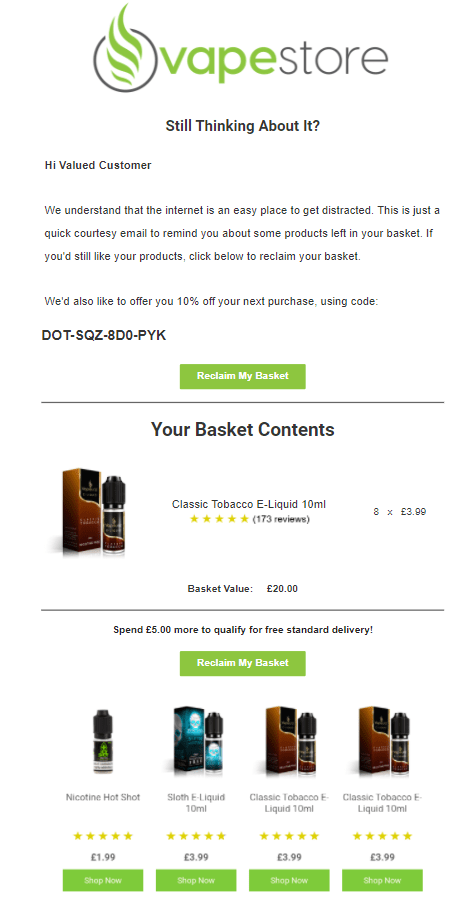
How to choose a shopping cart recovery solution
As the number one provider of cart recovery solution in the UK, we’re experts in what you should look out for when selecting a solution that can help you win back customers and generate revenue.
Is an integration offered?
A cart recovery solution that integrates with your email service provider (ESP) and eCommerce platform will allow you to start sending cart recovery emails quickly and easily.
How well can the solution identify shoppers?
Being able to identify your online shoppers is crucial for any remarketing activity. Look for a provider that can recognize shoppers across channels, rather than losing track of a customer if they revisit the website from a different device.
With Fresh Relevance, not only can you capture data when people log in and create an account, but you can also capture an email address from anywhere else it can be inputted across a website – for example, a newsletter, pop-up, or transactional process.
We also integrate with all email service providers, which allows you to track customers who click back through to your website from your cart recovery email. Using such a sophisticated cart recovery solution can quadruple the amount of shoppers you can identify, which could result in fourfold return on investment.
What type of dynamic content can the solution offer?
In order to win back as many cart abandoners as you can, you want to ensure that your recovery emails are as engaging as possible. Look for a solution that can offer dynamic content that updates in real-time, taking account of stock levels, and updating if the email hasn’t been opened by the time a deal ends.
Other key personalization features can include countdown timers and coupons, which can be added to create urgency or drive a customer to complete their purchase.
Can I develop a cart recovery solution in-house?
When ramping up your efforts to win back abandoners, you might be wondering how is best to approach it. Do you do it yourself? Or find a recovery solution that meets your needs?
If you consider developing a solution in-house, there are some points you’ll need to consider.
Recover more sales with cart abandonment
Congratulations!
You made it to the end of the Complete Guide to Cart Abandonment. Now you’re ready to put the tips and tricks listed here into action, to ensure that you win back as many shoppers as possible, and increase revenue for your brand.
To start recovering sales with cart abandonment email, check out Fresh Relevance’s industry-leading cart recovery solution.
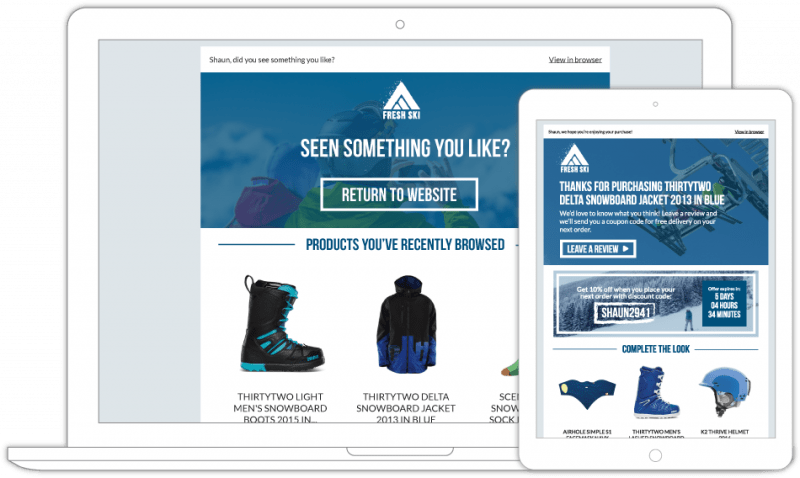
FAQs
What is average shopping cart abandonment rate for retail shoppers?
According to Statista, nearly three-quarters of all online retail shopping carts are abandoned. The rate is much higher for other eCommerce merchants, including travel (82%), fashion (88%), and cruise and ferry (98%).
Why is cart abandonment a problem for businesses and brands?
Cart abandonment signifies a breakdown in the conversion process. The lost sales opportunities mean lost revenue that impacts the company’s overall profitability and growth.
What is the difference between cart abandonment and checkout abandonment?
Cart abandonment occurs when a shopper adds items to their cart but leaves before completing the purchase. Checkout abandonment specifically refers to the point when a shopper starts the checkout process but abandons it before finalizing the transaction.



